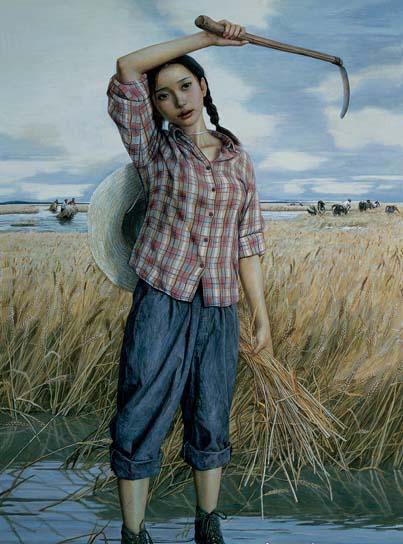Central Idea of the Poem
The central idea of the poem “Aunt Jennifer’s Tigers” by Adrienne Rich is how the power of the patriarchy controls women’s forms but not their minds. The poem makes this point by presenting the wild, interesting, powerful tigers embroidered by Aunt Jennifer and contrasting them with Aunt Jennifer herself. The poem characterizes the tigers as topaz residents of a world of green who do not fear men and pace in certainty around their perfect world. The happy words and assured verbs in the stanza are suggestive of self-possessed power. The next part shifts to Aunt Jennifer, who is stitching this vivid picture on a screen. She does not seem powerful at all. Her fingers are fluttering through the wool, and she can hardly pull the tiny needle because the massive weight of Uncle’s wedding band sits heavily on Aunt Jennifer’s hand. This image suggests something like a prisoner’s ball and chain and clearly symbolizes the dominating power of patriarchal institutions, such as marriage. The poem also predicts the future. There is no hope for Aunt Jennifer. Her bondage lasts until her death, when her frightened hands lie in a coffin, still dominated by men. Her tigers, however, continue unafraid on the screen she made. Although her body has died, still mastered by her ordeals, the tigers, the denizens of her imagination, persevere, royal and powerful. This is a feminist twist on the classic signature tune of art’s ability to live longer than human life.
The theme of the poem
The theme of women and feminism can be found in this poem. “Aunt Jennifer’s Tigers” sounds like a bead of good times. In reality, it is about a woman whose life has been limited by the patriarchal or male-dominated society in which she lives. But, the poem does not give us any facts about this. It does not tell us, for example, that Aunt Jennifer was not allowed to go to college or that Aunt Jennifer’s husband didn’t give her any say in financial matters. But the poem does firmly suggest that Aunt Jennifer’s prospects in life have been limited by her gender and also by her marriage, which left her terrified in her bad times.
In “Aunt Jennifer’s Tigers,” the restrictions that are problematic for Aunt Jennifer in life don’t bind her in art. So, at least, she has got that going for her. Aunt Jennifer’s needlework allows her to experience a world of deep green forests and brave dancing tigers. That is entirely different from the real life that she leads, which is weighed down by the sadness and limits of her marriage and her gender. Art in this poem is a kind of freedom, freedom available to everyone, even the disempowered.
When it comes to this poetry, immortality is pretty much right up there with love. The poet seems to be passionate about the idea of their immortality. So it is really no surprise that the theme of immortality, of life after death, is reflected in “Aunt Jennifer’s Tigers,” too. The speaker sees that the tigers will continue dancing after Aunt Jennifer’s death, and thus Aunt Jennifer will be able to live on through her art. Even though Aunt Jennifer’s wall hanging might not be so famous, she still gets to be immortal in her own way.
The tone of the poem
While the poem is theoretically dazzling, the subjects that art endures beyond human life and that suffering may be traded through art are almost not original. Rich, however, uses a resourceful image to reorganize these conventional themes in a new way and even hints, in the image of Aunt Jennifer weighed down by an oppressive marriage, at the feminism that would invade her later work. Yet the poem remains quite impersonal. The reader sees Aunt Jennifer but is not at all aware of the voice of the poem’s narrator. For the reader, it is as though the picture is framed by an invisible hand, in contrast to Rich’s later work, where the reader cannot help being aware of the poet’s personal presence.
Conclusion
The poem concludes by saying that the poet’s artwork will live on after her as a reminder of the dreams she never achieved. This poem of three four-line stanzas visualizes a relative whose leisure pursuit is needlework. Aunt Jennifer reveals her dreams of a happier life in her needlework. From the titles given to the adults, it seems as if the speaker is a child.
In the course of the poem, the relative, Aunt Jennifer, makes a panel with images of tigers marching proudly across it. The tigers are free, unlike their maker. Her sheet contains animals that are happier and more self-assured than she is. There is a certainty about them that their maker lacks in her. Aunt Jennifer paints confident, proud tigers. They are assured and confident inhabitants, inhabitants of their green world. ‘Denizen’ suggests independent citizen. It would seem that Jennifer is not an independent citizen of her own world. She is instead a wife, weighed down by duties, as we learn in the entire poem. Jennifer uses sharp and contrasting colors, sharp yellow against a green background. Her tigers are as bright as topaz, a yellow gem.
Her depiction contains an image of men under a tree, though the proud tigers show no fear of the men. This is brought up to show that they differ from Jennifer, who lives in fear of her husband to some extent. The tigers remind the poet of knights, full of courteousness and style. Chivalric men respected their women and acted kindly to them. Again, this seems to contrast with how Uncle behaved toward Aunt Jennifer according to what is mentioned in the poem.
In the poem, the poet describes Aunt Jennifer’s anxious hands struggling to pull the wool with her ivory needle. The word fluttering is suggestive of trembling. We get the impression of a fragile woman who finds it hard to pull her hand. It is exciting that if her needle is made of ivory, it may have come from an elephant’s tusk. Ivory is a bit like topaz, a precious material. As ivory involves the killing of elephants for their valuable tusks, it would seem that Jennifer may not care much for tigers in the wild or know much about their reality.
Thus, her artwork is unrealistic. Perhaps the poet feels it is a pointless and empty type of art. The poet humorously suggests that Aunt Jennifer’s fingers find it hard to hold the weight of her wedding ring and then pull the needle at the same time.
The wedding band is another mention of a precious substance, probably gold. By mentioning that it is Uncle’s wedding band, the poet suggests that Uncle owns Jennifer too and that, as a female, she is the property of her husband. The words massive and heavily put forward that Aunt Jennifer lives a demanding sort of life in which she has to attend to her husband’s needs and bear out his instructions. As a result, she is somewhat wiped out in her old age.
In the poem, the poet concludes by predicting that when Aunt Jennifer dies, her hands will look worn from all her needlework and the hard time she has trying to make her husband happy. Aunt Jennifer is ringed, trapped in her marriage, and controlled like an animal. Her husband is her master.
Grammar and spelling edited by Anjali Roongta on 7th April 2023
Some online learning platforms provide certifications, while others are designed to simply grow your skills in your personal and professional life. Including Masterclass and Coursera, here are our recommendations for the best online learning platforms you can sign up for today.
The 7 Best Online Learning Platforms of 2022
- Best Overall: Coursera
- Best for Niche Topics: Udemy
- Best for Creative Fields: Skillshare
- Best for Celebrity Lessons: MasterClass
- Best for STEM: EdX
- Best for Career Building: Udacity
- Best for Data Learning: Pluralsight

















very nice and critical analysis